The Radial Filter - A Most Useful Tool
In the article on Leading Light I referred to learning techniques on how to create light in your photos and referred you to the now slightly outdated YouTube video by Serge Ramelli. This video on the use of radial filters to create light is the technique I have employed the most for adjusting light in areas of my images. The radial filter is simply a mask that affects portions of your image. As used in Lightroom or Adobe Camera Raw, you don’t actually see the mask as a separate layer the way you would if you were just creating a mask on a separate layer in Photoshop. Since you don't see the mask when you are back in the layers panel in Photoshop, you will have difficulty making changes changes to the mask as you work. For this reason, it is good practice to duplicate your current layer (or copy multiple layers and merge them if the top layer isn't 100% opacity) and label the new layer with the actions you are performing on that layer each time you go back in forth from PS to ACR. Some users prefer to work solely in LR. If you do this, you will want to use the History panel in LR to keep track of your actions.
Since we have already used the radial filters in the Leading Light article, this month’s article is going to describe ways you might want to adjust your radial filters by applying additional filters (masks) to them. Next month we will cover more challenging masks and the uses of a more recent addition to Adobe’s programs, the Object Selection tool.
The image below has initial global changes performed on the RAW file in Lightroom. If you are not experienced in using the masking tool in LR or ACR, it is suggested that you work along on with the image on your computer. Find a high quality jpg here.
I generally start with a plan. There are several areas that I would like to modify where I might apply the Radial Filter in conjunction with other filters (masks). These are:
1. Accentuate the blowing rain on the right side. Since the rain crosses the horizon line, it is not will not work to separate the sky from the land using the sky selection filter.
2. Create increased warmth on the sunlit areas in the lower center.
3. Increase the luminance of the river.
4. Increase the luminance of the inversion layer clouds in the center of the image.
5. Increase the contrast of the ridges that are closest to the viewer.
If you have never used a mask in Lightroom or Adobe Camera Raw, review this section to understand the steps you will take to start with a mask. Once you have your mask placed over the image, any changes you make with the available sliders will only change the masked area.






You can see the brighter and slightly bluer river in the image below. Also note that a more complicated mask was emplyed to brighten the sun rays on the left side of the canyon. Because this involved separating the sky from the land, the mask was more complicated. Details on how this was done will be included in a later article.


We have made substantial progress on this image. Once you are comfortable with masks, these steps would only take a few minutes. In the next article, we will continue with this image to demonstrate more complicated masks and the use of the recently added Object selection mask.
